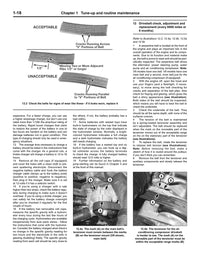All Haynes Digital Online Manuals feature everything you love about our books in an instantly accessible digital online form, that you can use via any device with an internet connection.
This page is taken from our digital online manual 38040 for the 2005-17 Chevrolet Equinox, 2010-17 GMC Terrain, and 2006-09 Pontiac Torrent, 2WD or 4WD with 4 cylinder or V6 engines.
The oxygen (O2) sensor informs the engine computer how much free oxygen is in the exhaust, allowing it to judge exactly how much fuel to provide for best power, economy, and emissions. There is no set time when O2 sensor should be replaced, but 100,000 miles or 5 years is a good guideline, or when the check engine light indicates a fault.
Note: Because it is installed in the exhaust manifold or pipe, both of which contract when cool, an oxygen sensor might be very difficult to loosen when the engine is cold. Rather than risk damage to the sensor or its mounting threads, start and run the engine for a minute or two, then shut it off. Be careful not to burn yourself during the following procedure.
Be particularly careful when servicing an oxygen sensor and follow these guidelines:
A) Oxygen sensors have a permanently attached pigtail and an electrical connector that cannot be removed. Damaging or removing the pigtail or electrical connector will render the sensor useless.
B) Keep grease, dirt and other contaminants away from the electrical connector and the louvered end of the sensor.
C) Do not use cleaning solvents of any kind on an oxygen sensor.
D) Oxygen sensors are extremely delicate. Do not drop a sensor or handle it roughly.
E) Make sure that the silicone boot on the sensor is installed in the correct position. Otherwise, the boot might melt and it might prevent the sensor from operating correctly.
Replacement
Upstream oxygen sensors
Note: These sensors are either in the exhaust pipe or screwed directly into the exhaust manifold(s). The 2.4L four-cylinder and 3.4L V6 engines have two oxygen sensors; one in the rear exhaust manifold and one in the exhaust pipe after the catalytic converter. The 3.0L and 3.6L V6 have four oxygen sensors; one in each exhaust manifold, and one just after each catalytic converter.
- If your vehicle is equipped with the 2.4L four-cylinder, or 3.0L or 3.6L V6 engine, remove the cosmetic engine cover.
- If your vehicle is equipped with the 3.4L V6 engine, raise the vehicle and support it securely on jack stands.
- (See illustration) Disconnect the upstream oxygen sensor electrical connector. Unclip the wire pigtail it from any retainers.
On 3.4L V6 engines, the upstream oxygen sensor is located in the rear exhaust manifold. On 3.6L V6 engines, there are two upstream oxygen sensors, one in each exhaust manifold. This picture is taken fron under the vehicle looking up.

Remove the upstream oxygen sensor.
If you’re going to reinstall the old sensor, apply anti-seize compound to the threads of the sensor to facilitate future removal.
If you’re installing a new oxygen sensor, it’s not necessary to apply anti-seize compound to the threads; the threads on new sensors already have anti-seize compound on them.Installation is the reverse of removal. Be sure to tighten the oxygen sensor securely.
Downstream oxygen sensors
- Raise the vehicle and support it securely on jack stands.
- (See illustration) Locate the downstream oxygen sensor, then trace the lead up to the electrical connector and disconnect the connector.
The downstream oxygen (O2) sensor or sensors are located in the exhaust pipe, just after the catalytic converter(s). This sensor informs the computer how well the convertor is functioning.

- Unscrew the downstream oxygen sensor.
- If you’re going to reinstall the old sensor, apply anti-seize compound to the threads of the sensor to facilitate future removal.
If you’re installing a new oxygen sensor, it’s not necessary to apply anti-seize compound to the threads. The threads on new sensors already have anti-seize compound on them. - Installation is the reverse of removal. Be sure to tighten the oxygen sensor securely.


























